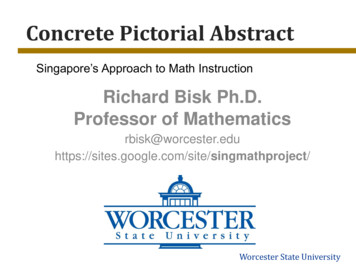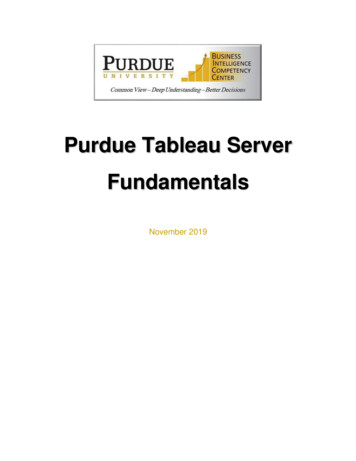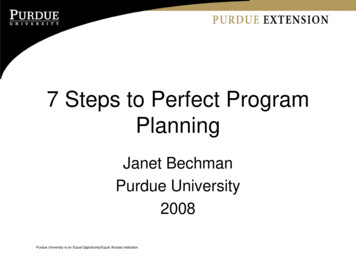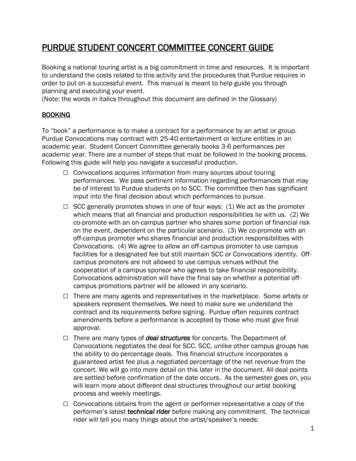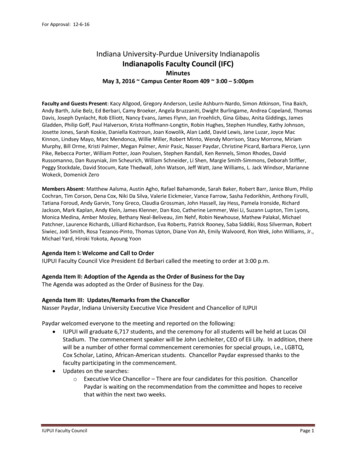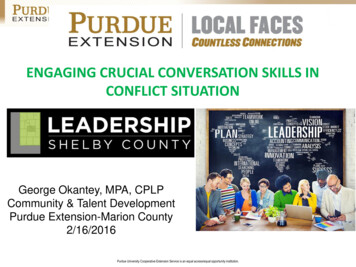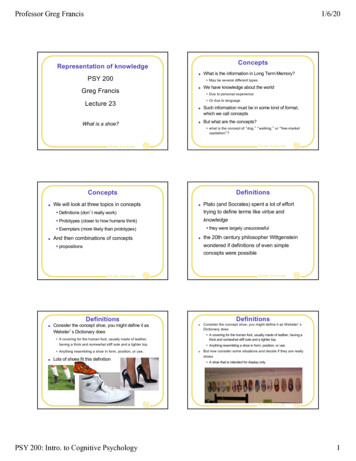
Transcription
Professor Greg Francis1/6/20ConceptsRepresentation of knowledgePSY 200Greg Francis w May be several different types We have knowledge about the worldw Due to personal experiencew Or due to languageLecture 23 What is a shoe?What is the information in Long Term Memory? Such information must be in some kind of format,which we call conceptsBut what are the concepts?w what is the concept of dog,capitalism ?Purdue UniversityPurdue UniversityDefinitionsConcepts w Definitions (don t really work)Plato (and Socrates) spent a lot of efforttrying to define terms like virtue andw Prototypes (closer to how humans think)knowledgeWe will look at three topics in concepts w they were largely unsuccessfulw Exemplars (more likely than prototypes) And then combinations of concepts the 20th century philosopher Wittgensteinwondered if definitions of even simpleconcepts were possiblew propositionsPurdue UniversityPurdue UniversityDefinitionsDefinitions Consider the concept shoe, you might define it asWebster s Dictionary does having a thick and somewhat stiff sole and a lighter top.w Anything resembling a shoe in form, position, or use.Lots of shoes fit this definitionPurdue UniversityPSY 200: Intro. to Cognitive PsychologyConsider the concept shoe, you might define it as Webster sDictionary doesw A covering for the human foot, usually made of leather, having athick and somewhat stiff sole and a lighter top.w A covering for the human foot, usually made of leather, walking, or free-marketw Anything resembling a shoe in form, position, or use. But now consider some situations and decide if they are reallyshoesw A shoe that is intended for display onlyPurdue University1
Professor Greg Francis1/6/20DefinitionsDefinitions Consider the concept shoe, you might define it as Webster sDictionary does w A covering for the human foot, usually made of leather, having athick and somewhat stiff sole and a lighter top.w for any definition you come up with, I can find examples that donot seem to fit the definitionw Anything resembling a shoe in form, position, or use. The difficulty is the same one that Plato and Socrateshad trying to define virtueBut now consider some situations and decide if they are reallyshoes But we all know what a shoe isw so our knowledge of this concept must not be based on someprecise definitionw a shoe filled with cement, which cannot be wornw a covering worn on the handsof a person without legs whowalks on his hands w And this? àNote, scientists can (sometimes) create precisedefinitions (e.g., a dog is defined by a DNA pattern orby mating abilities)w but the definition is somewhat arbitraryPurdue UniversityPurdue UniversityPrototypesPrototypes Perhaps what defines a concept is similarityamong its membersw there may be no absolutely necessary characteristics In prototype theory it is possible for an object tobe more or less a certain conceptConsider the concept coffee cupw there may be no absolutely sufficient characteristics Prototype theory supposes that similarity isjudged relative to a prototype example of theconceptw e.g., an ideal, average, or most frequent version of theconceptPurdue UniversityPurdue UniversityPrototypesPrototypes In prototype theory it is possible for an object tobe more or less a certain conceptConsider the concept coffee cupw and variations (some are cup-ier than others)Purdue UniversityPSY 200: Intro. to Cognitive Psychology In prototype theory it is possible for an object tobe more or less a certain conceptConsider the concept coffee cupw and variations (some are cup-ier than others)Purdue University2
Professor Greg Francis1/6/20PrototypesPrototypes In prototype theory it is possible for an object tobe more or less a certain conceptConsider the concept coffee cup In prototype theory it is possible for an object tobe more or less a certain conceptConsider the concept coffee cupw and variations (some are cup-ier than others)w and variations (some are cup-ier than others)Purdue UniversityPurdue UniversityPrototypesPrototypes Lots of experiments suggest the role ofprototypes Prototypesw Posner & Keele (1968): learning category names forrandom dot patternsw Discriminate two sets of random dot patternsw Each pattern is a variation of one of two prototypepatternsABPurdue UniversityPurdue UniversityPrototypesPrototypes variations are made by moving some of the dots The key test is done after subjects learn to classify thevariantsw reaction time for judgment is recorded for stimuli they have neverseen before» new variants» the prototypesw reaction time is faster for the prototypesw which suggests that the mental representation of the categories(concepts) are built to favor the prototype of the categoryvariant of A variant of B Look at CogLab datasubjects learn to classify many different variantsw they never see the prototypes themselvesPurdue UniversityPSY 200: Intro. to Cognitive PsychologyPurdue University3
Professor Greg Francis1/6/20PrototypesPrototypes Results are based on data from 145 participants (39,285 for global).w Pattern typeReaction time (ms)Global RT(ms)w Prototypes798969w Variants8431000Consider the types of concepts you can have things: bird, dog, chair, shoe, actions: walking, running, sleeping, w and how specific they can beUnanswered by this (and many other) experiments is what a prototype is:w a thing that resides in memory and contains information about the categoryfeatures?w the result of processing information? A bit of thought suggests it is the result of processing informationgoal-derived: things to eat on a diet , things to carry out of a housein case of a fire ,.ad hoc: things that could fall on your head , things you might seewhile in Paris , gifts to give one s former high school friend who hasjust had her second baby ,. When studied, these concepts all seem to have prototypecharacteristicsPurdue UniversityPurdue UniversityExemplarsPrototypes We can generate new concepts from oldconcepts A concept consists of lots of examples of theconceptw e.g., a coffee cup concept might contain lots ofexamples of coffee cupsw it s inconceivable that every possible prototype existsready to be usedw some must just be built as they are neededw perhaps even the prototypes for simple concepts likebird or shoe are also just built when they areneeded A theory that can account for this processingapproach is exemplar theoryPurdue UniversityPurdue UniversityExemplarsExemplars Comparing an object to see if it is a coffee cupinvolves comparing it to each example in memoryand seeing if it matches anything well enoughPurdue UniversityPSY 200: Intro. to Cognitive Psychology Even if it is a new object, it may match severalexemplars well enough to generate an overallresponse to indicate it is a coffee cupPurdue University4
Professor Greg Francis1/6/20ExemplarsExemplars Some coffee cups seem prototypical becausethey match lots of exemplars w that s what defines a prototype Unlike prototype theory, exemplar theory also containsinformation about the variability of examples within aconceptThus, we know that pizzas have an average size of 16inches but can come in lots of different sizesAnd we know that foot-long rulers have an average sizeof 12 inches, but essentially no variability in sizePurdue UniversityPurdue UniversityPropositionsComplex associations How do we represent a concept thatinvolves combinations of concepts?w e.g., Dogs chase cats. Higher order ideas Statement that is either true or falsew things doing somethingw things cannot be judged true or falsew e.g., Last Spring, Jacob fed the pigeons inTrafalgar Square. w e.g., Book, Albert, Threw, Professor, Test, Gavew consists of an ordered list of conceptsNeed to identify the role of each concept» e.g., (relation:X, Agent:Y, Object:Z)Albert threw the book.(relation:Threw, Agent:Albert, Object:Book)(Threw, Albert, Book)Purdue UniversityPurdue UniversityPropositionProposition Network Representation w The proposition connects the appropriate conceptnodesNetwork Representationw The proposition connects the appropriate concept nodesProfessorAlbertagentagentthrewAlbert threw the bookgaveThe professor gave a testrelationrelationobjectbookPurdue UniversityPSY 200: Intro. to Cognitive PsychologyobjecttestPurdue University5
Professor Greg Francis1/6/20PropositionProposition Network Representation Network Representationw The proposition connects the appropriate concept nodeslast SpringtimeDogobjectagentJacobchaseDogs chase catsinLast Spring, Jacob fed pigeonsrelationpigeons inTrafalgar afalgar SquarePurdue UniversityfeedscatPurdue UniversityPropositionProposition Ratcliff & McKoon (1978)w study phase One way of combining concepts» subjects are asked to memorize a set of 504 sentences» 18 - 1 hour sessions!w there are also other theories of how to do this Used a lot in Artificial Intelligence Do humans represent interactions ofw test phase» show words and have subjects decide if they were in thestudy sentences or not» measure reaction time for words from the sentencesconcepts with propositions? Some experimental evidenceThe bandit who stole the passport faked the signaturePurdue UniversityPurdue UniversityPropositionProposition Network RepresentationIn the test phase, a word is given and thesubject responds as quickly as possiblepassportpassportagentbanditagentbandit stole passportrelationobjectsignaturePurdue UniversityPSY 200: Intro. to Cognitive Psychologyfakedbandit stole passportrelationbandit faked signaturebandit faked ctobjectrelationobjectstolesignaturePurdue University6
Professor Greg Francis1/6/20PropositionProposition In the test phase, a word is given and thesubject responds as quickly as possiblepassport The expectation is that activation will flow through theentire proposition that includes this tagentbandit stole passportrelationrelationrelationbandit faked gnaturePurdue UniversityPurdue UniversityPropositionPropositionSo, if the next word is part of the same proposition, asubject will respond even fasterpassport If words are from different propositions, nditagentfakedbandit stole passportrelationrelationbandit faked signaturebandit faked naturesignaturePurdue UniversityPurdue UniversityPropositionPropositionIn the test phase, a word is given and thesubject responds as quickly as possiblepassport Activation will flow through the entire proposition thatincludes this tagentbanditfakedfakedbandit stole passportrelationbandit stole passportobjectstolesignaturePurdue UniversityPSY 200: Intro. to Cognitive Psychologyrelationbandit faked signaturebandit faked signaturerelationbanditfakedbandit stole passport fakedbandit stole passportbandit faked signature banditfakedrelationobjectstolesignaturePurdue University7
Professor Greg Francis1/6/20Proposition PropositionWhen the next word is shown, its node has not beenprimed, so it responds more slowly Test Phase : Priming Taskw compare RTs for second in a pair of wordsw within a common proposition (bandit -- passport)passportsignaturew between propositions (passport -- signature)objectw not related in sentence (horizon -- signature)agentw interested in RT to second word in each pairbanditfakedbandit stole passport relationw results» within same proposition words: 561 msec» between proposition words: 581 msec» unrelated: 671bandit faked signaturerelationRatcliff & McKoon (1978)objectw evidence of priming by propositional activationstolesignaturePurdue University We think in propositions!Conclusions Conceptsw definitions Purdue UniversityNext time Other types of knowledge Mental imagesw prototypesw mental rotationw exemplarsw mental scalingw limitations ofPropositionsw Evidence we think in terms of propositionsPurdue UniversityPSY 200: Intro. to Cognitive Psychology CogLab on Mental rotation due! Is a picture in your head like a picture in the world?Purdue University8
wAnything resembling a shoe in form, position, or use. Lots of shoes fit this definition Purdue University Definitions Consider the concept shoe,you might define it as Webster s Dictionary does wA covering for the human foot, usually made of leather,
